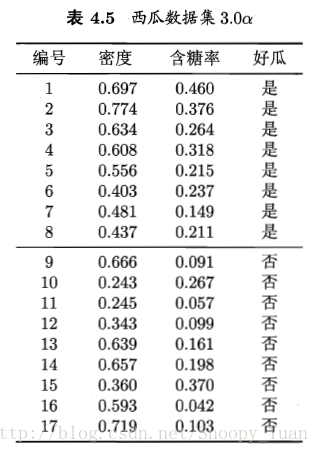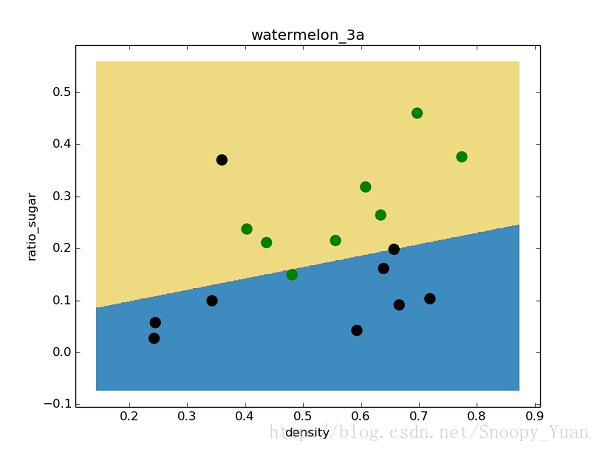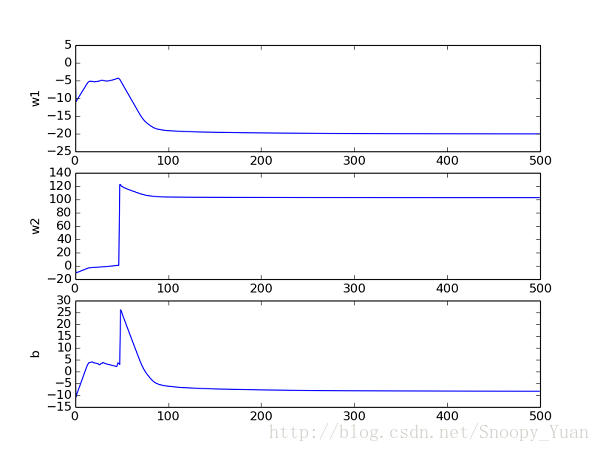这里采用Python-sklearn的方式,环境搭建可参考 数据挖掘入门:Python开发环境搭建(eclipse-pydev模式).
相关答案和源代码托管在我的Github上:PY131/Machine-Learning_ZhouZhihua.
思路概要
编程实现对率回归:
* 采用sklearn逻辑斯蒂回归库函数实现,通过查看混淆矩阵,绘制决策区域来查看模型分类效果;
* 自己编程实现,从极大化似然函数出发,采用梯度下降法得到最优参数,然后尝试了随机梯度下降法来优化过程。
3.3 编程实现对率回归
所使用的数据集如下:
本题是本书的第一个编程练习,采用了自己编程实现和调用sklearn库函数两种不同的方式,详细解答和编码过程:(查看完整代码):
1.获取数据、查看数据、预处理:
观察数据可知,X包含(密度、含糖量)两个变量,y为西瓜是否好瓜分类(二分),由此生成.csv数据文件,在Python中用Numpy读取数据并采用matplotlib库可视化数据:
样例代码:
'''
data importion
'''
import numpy as np
import matplotlib.pyplot as plt
# load the CSV file as a numpy matrix
dataset = np.loadtxt('../data/watermelon_3a.csv', delimiter=",")
# separate the data from the target attributes
X = dataset[:,1:3]
y = dataset[:,3]
# draw scatter diagram to show the raw data
f1 = plt.figure(1)
plt.title('watermelon_3a')
plt.xlabel('density')
plt.ylabel('ratio_sugar')
plt.scatter(X[y == 0,0], X[y == 0,1], marker = 'o', color = 'k', s=100, label = 'bad')
plt.scatter(X[y == 1,0], X[y == 1,1], marker = 'o', color = 'g', s=100, label = 'good')
plt.legend(loc = 'upper right')
plt.show()数据散点图:
2.采用sklearn逻辑回归库函数直接拟合:
虽然样本量很少,这里还是先划分训练集和测试集,采用sklearn.model_selection.train_test_split()实现,然后采用sklearn.linear_model.LogisticRegression,基于训练集直接拟合出逻辑回归模型,然后在测试集上评估模型(查看混淆矩阵和F1值)。
样例代码:
'''
using sklearn lib for logistic regression
'''
from sklearn import model_selection
from sklearn.linear_model import LogisticRegression
from sklearn import metrics
# generalization of test and train set
X_train, X_test, y_train, y_test = model_selection.train_test_split(X, y, test_size=0.5, random_state=0)
# model training
log_model = LogisticRegression()
log_model.fit(X_train, y_train)
# model testing
y_pred = log_model.predict(X_test)
# summarize the accuracy of fitting
print(metrics.confusion_matrix(y_test, y_pred))
print(metrics.classification_report(y_test, y_pred))得出混淆矩阵和相关度量(查准率(准确率)、查全率(召回率),F1值)结果如下:
[[4 1]
[1 3]]
precision recall f1-score support
0.0 0.80 0.80 0.80 5
1.0 0.75 0.75 0.75 4
avg / total 0.78 0.78 0.78 9由混淆矩阵可以看到,由于样本本身数量较少,模型拟合效果一般,总体预测精度约为0.78。为提升精度,可以采用自助法进行重抽样扩充数据集,或是采用交叉验证选择最优模型。
下图是采用matplotlib.contourf绘制的决策区域和边界,可以看出对率回归分类器还是成功的分出了绝大多数类:
3.自己编程实现逻辑斯蒂回归
编程实现逻辑回归的主要工作是求取参数w和b(见书p59),最常用的参数估计方法是极大似然法,由于题3.1已经证得对数似然函数(见书3.27)是凸函数,存在最优解,这里考虑采用梯度下降法来迭代寻优。
回顾一下Sigmoid函数,即逻辑斯蒂回归分类器的基础模型:
目的是基于数据集求出最优参数w和b,最常采用的是极大似然法,参数的似然函数为:
根据书p59,最大化上式等价于最小化下式:
题3.2已证上式为凸函数,一定存在最小值,但按照导数为零的解析求解方式较为困难,于是考虑采用梯度下降法来求解上式最小值时对应的参数。
注:梯度下降法基本知识可参考书中附录p409页,也可直接采用书中p60式3.30偏导数公式。书中关于参数迭代改变式子如下:
对于迭代,可每次先根据(B.16)计算出梯度▽f(β),然后由(B.17)更新得出下一步的Δβ。
接下来编程实现基本的梯度下降法:
(1)首先编程实现对象式3.27:
def likelihood_sub(x, y, beta):
'''
@param x: one sample variables
@param y: one sample label
@param beta: the parameter vector in 3.27
@return: the sub_log-likelihood of 3.27
'''
return -y * np.dot(beta, x.T) + np.math.log(1 + np.math.exp(np.dot(beta, x.T)))
def likelihood(X, y, beta):
'''
@param X: the sample variables matrix
@param y: the sample label matrix
@param beta: the parameter vector in 3.27
@return: the log-likelihood of 3.27
'''
sum = 0
m,n = np.shape(X)
for i in range(m):
sum += likelihood_sub(X[i], y[i], beta)
return sum (2)然后基于训练集(注意x->[x,1]),给出基于3.27似然函数的定步长梯度下降法,注意这里的偏梯度实现技巧:
'''
@param X: X is the variable matrix
@param y: y is the label array
@return: the best parameter estimate of 3.27
'''
def gradDscent_1(X, y): #implementation of basic gradDscent algorithms
h = 0.1 # step length of iteration
max_times= 500 # give the iterative times limit
m, n = np.shape(X)
beta = np.zeros(n) # parameter and initial to 0
delta_beta = np.ones(n)*h # delta parameter and initial to h
llh = 0
llh_temp = 0
for i in range(max_times):
beta_temp = beta.copy()
# for partial derivative
for j in range(n):
beta[j] += delta_beta[j]
llh_tmp = likelihood(X, y, beta)
delta_beta[j] = -h * (llh_tmp - llh) / delta_beta[j]
beta[j] = beta_temp[j]
beta += delta_beta
llh = likelihood(X, y, beta)
return beta通过追踪参数,查看其收敛曲线,然后来调节相关参数(步长h,迭代次数max_times)。下图是在当前参数取值下的beta曲线,可以看到其收敛良好:
(3)最后建立Sigmoid预测函数,对测试集数据进预测,得到混淆矩阵如下:
[[ 4. 1.]
[ 1. 3.]]可以看出其总体预测精度(7/9 ≈ 0.78)与调用sklearn库得出的结果相当。
(4)采用随机梯度下降法来优化:上面采用的是全局定步长梯度下降法(称之为批量梯度下降),这种方法在可能会面临收敛过慢和收敛曲线波动情况的同时,每次迭代需要全局计算,计算量随数据量增大而急剧增大。所以尝试采用随机梯度下降来改善参数迭代寻优过程。
随机梯度下降法的核心思想是增量学习:一次只用一个新样本来更新回归系数,从而形成在线流式处理。
同时为了加快收敛,采用变步长的策略,h随着迭代次数逐渐减小。
给出变步长随机梯度下降法的代码如下:
def gradDscent_2(X, y): #implementation of stochastic gradDscent algorithms
'''
@param X: X is the variable matrix
@param y: y is the label array
@return: the best parameter estimate of 3.27
'''
import matplotlib.pyplot as plt
m, n = np.shape(X)
h = 0.5 # step length of iterator and initial
beta = np.zeros(n) # parameter and initial
delta_beta = np.ones(n) * h
llh = 0
llh_temp = 0
for i in range(m):
beta_temp = beta.copy() # for partial derivative
for j in range(n):
h = 0.5 * 1 / (1 + i + j) # change step length of iterator
beta[j] += delta_beta[j]
llh_tmp = likelihood_sub(X[i], y[i], beta)
delta_beta[j] = -h * (llh_tmp - llh) / delta_beta[j]
beta[j] = beta_temp[j]
beta += delta_beta
llh = likelihood_sub(X[i], y[i], beta)
return beta
得出混淆矩阵:
[[ 3. 2.]
[ 0. 4.]]从结果看到的是:由于这里的西瓜数据集并不大,所以随机梯度下降法采用一次遍历所得的结果不太好,参数也没有完成收敛。这里只是给出随机梯度下降法的实现样例,这种方法在大数据集下相比批量梯度法应会有明显的优势。
参考链接:
由于这是本书第一个编程,索引资料较多,择其重要的一些列出如下:
- Introduction to Machine Learning with Python and Scikit-Learn
- scikit-learn官方主页
- matplotlib官方主页
- 随机梯度下降(Stochastic gradient descent)和批量梯度下降(Batch gradient descent)的公式对比、实现对比
- 机器学习算法与Python实践之(七)逻辑回归(Logistic Regression)
- plot decision boundary matplotlib
Ask(matplotlib决策区域和边界绘制 - Python数据可视化——散点图
最后
以上就是平淡导师最近收集整理的关于周志华《机器学习》课后习题解答系列(四):Ch3.3 - 编程实现对率回归的全部内容,更多相关周志华《机器学习》课后习题解答系列(四):Ch3.3内容请搜索靠谱客的其他文章。










![【Pre-Training】超细节的 BERT/Transformer 知识点1.不考虑多头的原因,self-attention 中词向量不乘 QKV 参数矩阵,会有什么问题?2.为什么 BERT 选择 mask 掉 15% 这个比例的词,可以是其他的比例吗?3.使用 BERT 预训练模型为什么最多只能输入 512 个词,最多只能两个句子合成一句?4.为什么 BERT 在第一句前会加一个 [CLS] 标志?5.Self-Attention 的时间复杂度是怎么计算的?6.Transformer 在](https://file2.kaopuke.com:8081/files_image/reation/bcimg11.png)






发表评论 取消回复